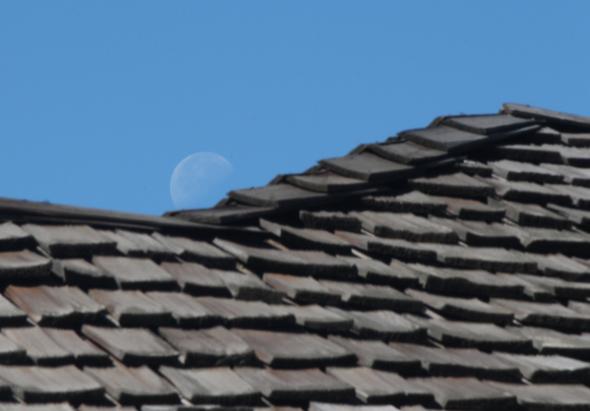I deal with misconceptions in astronomy all the time. Some are fun to talk to about, like why the Moon looks bigger on the horizon; while others are more pernicious, like the idea that NASA faked the Moon landings.
Others are simple, and relatively easy to correct. For example, a lot of folks think the Moon is only up at night*. That’s simply not true; the Moon is up during the day as well, not-so-coincidentally half the time. It’s not always easy to see during the day, especially if it’s near the Sun, but it’s there.
I suspect the reason a lot of people think the Moon’s only up at night is because that’s the only time they’ve ever noticed it. After all, when the sky’s dark the Moon sticks out pretty well! But it’s not all that hard to see it in bright daylight either, especially when it’s a crescent after sunset. It helps to have a little foreknowledge, too; like where the Moon is in the sky. That information’s available for free or using fairly inexpensive planetarium software.
I get a great view of it out my office window when it’s setting to the west. I was reminded of that this week when, after getting my daughter bundled up and off to school, I plopped down at my desk and glanced off to my right. I saw the gibbous (more than half full) Moon hanging over my neighbor’s house. I had almost the exact same view last month, in September, and when I saw it then I quickly slapped the telephoto lens on my camera and grabbed a few shots, including the one at the top of this post. I was pleased with how it turned out; the slightly softer focus on the roof emphasizes our cosmic neighbor. And just a few minutes later I was able to get this one:

Photo by Phil Plait
A minute later it was gone, set behind the artificial horizon. As I post this, the Moon will be well-placed for viewing in the morning after sunrise to the southwest and west for the rest of the week; I highly recommend looking for it if you can.
As to why the Moon can be seen in daytime, that’s not hard to understand. Basically, it orbits the Earth, and is lit by the Sun. As it circles our planet, we see the angle between it and the Sun change, and therefore the amount of the Moon we see lit changes. That angle between the Moon and the Sun also determines whether we see it more at night or during the day, too. If it’s near the Sun, we see very little of it lit (we’re looking on the dark side) and it’s up all day. If it’s opposite the Sun in the sky, it’s full, and up all night.
There are countless explanations of this online, though if I may be so immodest (ha!) you could start here, and then go here. I have links on those pages that’ll send you on your merry way. You can also try this for yourself! Find a sphere of some kind like a Ping Pong or tennis ball. Sit down near a bright lamp, and hold the ball up in front of your face, between you and the lamp. Note what it looks like, how much of the ball is illuminated. Now move it 45° to your left. How much of it do you see lit now? Now spin around, put the lamp behind you and the ball in front of you. Note the phase, and keep spinning. Hopefully, a little hands-on demo will make this a lot clearer in your mind.
And when you’re done with that, if I may reinforce an earlier thought as well: Go outside. The beauty of astronomy is that it’s right there over your head. Look up!
* Unlike like lots of other myths about astronomy, this is one that is really just anecdotal, based on my own experience; it’s not the kind of thing people tend to document when they see the Moon during the day. I know other astronomers have dealt with talking to the public about it as well. A search on the terms “moon daytime surprised” does yield some corroborating results.
